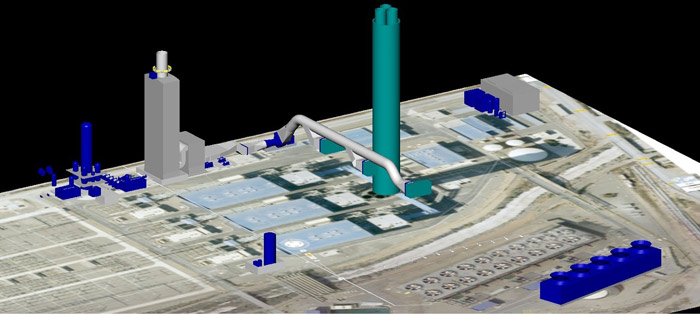
Although a natural-gas–combined-cycle plant emits about half the carbon dioxide of a conventional coal plant, a massive transition from coal- to gas-powered plants is not enough to adequately address the carbon reductions being contemplated domestically and internationally. “Just switching everything to natural gas won’t get you the carbon reduction levels needed to meet the targets,” said EPRI’s Des Dillon.
Which is why Dillon and Dale Grace, both EPRI senior technical leaders, spearheaded a study on the performance and cost impacts of retrofitting Spanish utility Gas Natural Fenosa’s 1200-megawatt combined-cycle plant in Cartagena with carbon capture technology.
In most scenarios worldwide, carbon capture and storage (CCS) is uneconomical at natural gas and coal fired plants; installation of carbon capture equipment is unlikely near-term. A handful of small (10 to 25 megawatts) CCS demonstration projects worldwide has been followed by the 110-megawatt Boundary Dam coal plant in Canada, which opened last October as the first large-scale power generation facility built and operated with CCS. Its economics benefit from government support, Canada’s carbon legislation, and the sale of captured CO2 to nearby oil fields for enhanced oil recovery.
Site-Specific Guidance and Industry Cost Targets
The Cartagena analysis modeled a retrofit with commercially available technology based on the plant’s current equipment and site, providing the utility with guidance on performance and cost. “This work helps the utility make a compelling argument to regulators and the public that doing carbon capture now is difficult because of the economics,” said Dillon. “If the economics change, the utility is better positioned for a credible analysis of carbon capture retrofit.”
The study reveals the importance of evaluating the technology in the context of a plant’s specific layout, equipment, and market conditions. For example, natural gas is three to four times more expensive in Spain than in the United States. The Cartagena plant has a low capacity factor—meaning that it runs at low output levels—because of the country’s struggling economy and the addition of significant renewable energy over the past decade.
While these factors make a retrofit uneconomical now for Cartagena, the EPRI study outlines circumstances when it would make financial sense. The best-case scenario: running the plant at a capacity factor above 70% and retrofitting all three generation units for economies of scale.
Other takeaways include how to minimize the retrofit’s impact on plant efficiency and net power output, as well as impacts on site water use. The study provides cost and performance targets that carbon capture developers with new technology need to surpass.
But a bigger lesson may simply be the importance of being prepared for a future that includes more gas and significantly reduced carbon emissions. “These issues are not going away,” said Grace.
EPRI Technical Experts:
Dale Grace, Des Dillon


